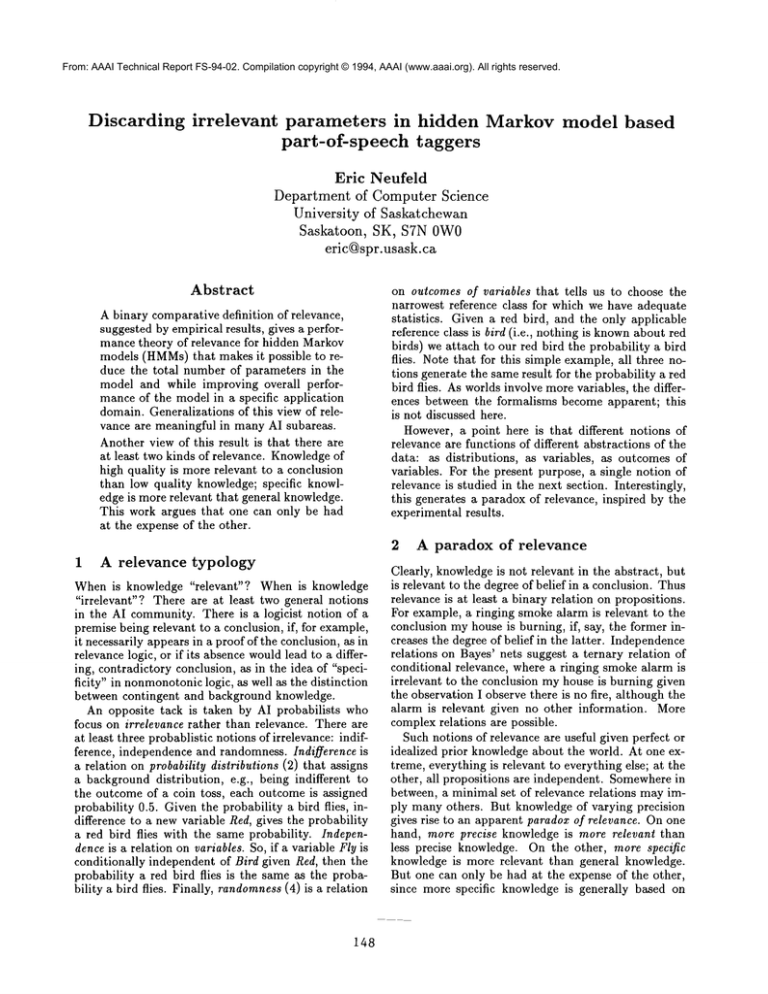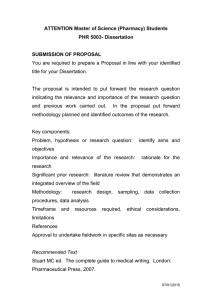
From: AAAI Technical Report FS-94-02. Compilation copyright © 1994, AAAI (www.aaai.org). All rights reserved.
Discarding
irrelevant
parameters in hidden Markov model based
part-of-speech
taggers
Eric Neufeld
Department
of Computer Science
University
of Saskatchewan
Saskatoon,
SK, S7N 0W0
eric@spr.usask.ca
Abstract
on outcomes of variables that tells us to choose the
narrowest reference class for which we have adequate
statistics.
Given a red bird, and the only applicable
reference class is bird (i.e., nothing is knownabout red
birds) we attach to our red bird the probability a bird
flies. Note that for this simple example, all three notions generate the same result for the probability a red
bird flies. As worlds involve morevariables, the differences between the formalisms become apparent; this
is not discussed here.
However, a point here is that different notions of
relevance are functions of different abstractions of the
data: as distributions,
as variables, as outcomes of
variables. For the present purpose, a single notion of
relevance is studied in the next section. Interestingly,
this generates a paradox of relevance, inspired by the
experimental results.
A binary comparative definition of relevance,
suggested by empirical results, gives a performance theory of relevance for hidden Markov
models (HMMs)that makes it possible to reduce the total number of parameters in the
model and while improving overall performanceof the model in a specific application
domain. Generalizations of this view of relevance are meaningful in many AI subareas.
Another view of this result is that there are
at least two kinds of relevance. Knowledgeof
high quality is more relevant to a conclusion
than low quality knowledge; specific knowledge is more relevant that general knowledge.
This work argues that one can only be had
at the expense of the other.
2
1
A relevance
typology
Whenis knowledge "relevant"?
When is knowledge
"irrelevant"? There are at least two general notions
in the AI community. There is a logicist notion of a
premise being relevant to a conclusion, if, for example,
it necessarily appears in a proof of the conclusion, as in
relevance logic, or if its absence wouldlead to a differing, contradictory conclusion, as in the idea of "specificity" in nonmonotoniclogic, as well as the distinction
between contingent and background knowledge.
An opposite tack is taken by AI probabilists who
focus on irrelevance rather than relevance. There are
at least three probablistic notions of irrelevance: indifference, independence and randomness. Indifference is
a relation on probability distributions (2) that assigns
a background distribution, e.g., being indifferent to
the outcome of a coin toss, each outcome is assigned
probability 0.5. Given the probability a bird flies, indifference to a new variable Red, gives the probability
a red bird flies with the same probability. Independence is a relation on variables. So, if a variable Fly is
conditionally independent of Bird given lied, then the
probability a red bird flies is the same as the probability a bird flies. Finally, randomness(4) is a relation
148
A paradox
of relevance
Clearly, knowledgeis not relevant in the abstract, but
is relevant to the degree of belief in a conclusion. Thus
relevance is at least a binary relation on propositions.
For example, a ringing smokealarm is relevant to the
conclusion myhouse is burning, if, say, the former increases the degree of belief in the latter. Independence
relations on Bayes’ nets suggest a ternary relation of
conditional relevance, where a ringing smokealarm is
irrelevant to the conclusion myhouse is burning given
the observation I observe there is no fire, although the
alarm is relevant given no other information. More
complex relations are possible.
Such notions of relevance are useful given perfect or
idealized prior knowledgeabout the world. At one extreme, everything is relevant to everything else; at the
other, all propositions are independent. Somewherein
between, a minimal set of relevance relations may imply many others. But knowledge of varying precision
gives rise to an apparent paradox of relevance. On one
hand, more precise knowledge is more relevant than
less precise knowledge. On the other, more specific
knowledge is more relevant than general knowledge.
But one can only be had at the expense of the other,
since more specific knowledge is generally based on
smaller samples. The practical question is, at what
point should a handful of exceptions cease to be dismissed as errors and becomean exceptional subclass?
This suggests a binary comparative relevance relation that defines when one sentence is more relevant
than another to inferring the probability of a proposition. Then, given several statements, which is the
most relevant?
Kyburg (4) suggests we use the narrowest class for
which adequate statistics are available, where a statistic is adequate when its interval value does not completely contain the interval associated with a more
general class, or that the difference between the two
interval values cannot be explained away by error.
The empirical study below suggests this is also practical; the best performanceresults followed the realization that the most specific knowledgeis not necessarily
the most relevant.
3
HMM based
part
of
speech
-ne -of-he -at -es -of-he -ic -ch -as -en -in -he
-in -of -ch -ng, -he -ss -of -ng -ts -of -ch -to
-ed -xt. -is -is -ly -ed -as -a -st -ep -ds -re -lt
-ks -ch -as -ng, -ch -es -ic -ge.
(a) Sampletext, all words truncated to two letters.
One of the great -es of the -ic approach has
been in the -in of-ch -ng, the process of-ng
parts of speech to -ed -xt. This is generally
considered as a first -ep towards moredifficult
-ks such as -ng, which -es -ic knowledge.
(b) Same text, 1000 most frequent words added.
One of the great -es of the -ic approach has
been in the -in of-ch -ng, the process of-ng
parts of speech to -ed text. This is generally
considered as a first step towards more difficult -ks such as -ng, which -es -ic knowledge.
tagging
A hidden Markov model trains on input-output pairs
to learn parameters of an unobservable process that
produces outputs. After training, the formalism is
tested on new outputs. In the work described here, the
model was trained on unrestricted natural language
text tagged with parts of speech. After training, the
model was tested on unseen text. The tag sequence
attached to a word sequence by our tagger is that maximizing
n
Hp(wi[ti )p(ti [ti-1
-ology, -ation) are used. In (1), statistics on all 2-,
and 4-letter endings are used. A surprising result was
that a tagger based on 3-letter endings alone outperformed taggers using 2- and 4- letter endings.
(1)
i=1
where wi, ti denote the ith word and tag type, respectively in an n-word sequence(5). Probabilities of the
type p(wi]ti) are called lexical probabilities; probabilities of the type p(ti[ti-1) are called contextual probabilities.
Neither the set of possible lexical probabilities nor
the set of possible contextual probabilties is bounded
by the training data and as a consequence a major
problem is handling unseen words and tag sequences
in the test data. The problem of unseen tag sequences
is handled by the Good-Turing method; not discussed
here. The problem of unseen words is significant. We
found a 900000token training set contained only 45000
unique words, half of which occurred exactly once. A
disjoint 100000 token test set contained about 4000
words that had not been seen in the training set. Although some were specialized jargon, many(e.g., outjumped, galaxy) simply reflect the vastness of human
experience.
In previous work, one technique for handling unseen
wordsis using statistics collected from the training corpus wheneverpossible and revert to a secondary strategy based on other word features for unseen words.
In (3) capitalization is used to identify nouns. In (6),
statistics on a small predefined word ending set (e.g.,
149
(c) Same text 7 3000 most frequent words added.
Figure 1: A little
knowledgehelps a lot.
If 3-letter ending knowledgeoutperforms 2-letter or
4-letter ending knowledge, 3-letter ending knowledge
might outperform whole-word knowledge. This suggests the following novel approach: rather than tag
words as a primary strategy and revert to an endingbased strategy for unseen words, tag endings as a primary strategy and revert to a word-based strategy for
frequent words, for which the best possible statistics
are available. Figure 1 gives the idea.
A strictly ending-based strategy doesn’t outperform
a word-based strategy, although performance is good.
Using l-letter endings results in a 70%success rate; 4letter endings give about a 90- -95% success rate and
performance tends to improve with the ending length.
An unexpected result: performance improved, surpassing the word-based tagger by a significant 0.5%,
and then declined as statistics based on small sample
sizes were added. Figure 2 gives results, where entries
A, B, C, Dindicate different effective tag list strategies,
(not discussed here), L is word-ending length, and
is number of whole words added back.
4
Conclusions
Here relevance is seen as trading quantity of knowledge
against quality of knowledge. There are several ways
of looking at this, e.g., as a way of providing a compact
but efficient representations of domainstructure, i.e.,
with the fewest parameters, as in neural nets. Or, as in
nonmonotonic logic, we don’t need to remember that
Exp.
L=2
A
B
C
D
L=3
A
B
C
D
N (x 1000)
5
20
0
1
89.9
89.9
83.9
83.9
96.0
96.1
96.0
96.1
97.0
97.1
97.0
97.1
97.2
97.4
93.6
97.4
94.4
94.4
91.2
91.2
96.5
96.6
96.5
96.6
97.0
97.1
97.0
97.1
97.0
97.0
94.9
97.2
30
[6] Marie Meteer, Richard Schwartz, and Ralph
Weischedel. POST: Using probabilities
in language processing. In IJCAI-91, pages 960-965,
Sydney, Australia, August 1991.
[7] Judea Pearl. 1988. Probabilistic Reasoning in Intelligent Systems. Morgan Kaufmann, California.
45
97.2
96.1
97.4
93.7
93.7
97.4
V-~
96.9
97.2
94.8
97.2
96.1
96.6
94.1
96.5
Figure 2: Tokens Correctly Tagged
each kind of bird flies, except penguins; we remember that birds fly but penguins don’t. Nonmonotonic
logic in this sense is efficient in that by focussing on
what is relevant, it minimizes the number of parameters, although older treatments miss the issue of quality of knowledge. This idea of relevance also seems
closely related to overfilling in machine learning -treating observational data as perfect information sacrifices flexibility. Yet another view: this relevance can
be seen as aiding in deciding when one has acquired
enough evidence to make a decision.
Another view is that we consider that there are
two kinds of relevance -- ceteris paribus, high quality
knowledgeis more relevant than low quality; similarly,
more representative knowledge is more relevant than
less. But one can be had only at the expense of the
other.
References
[1] Greg Adams and Eric Neufeld. Automated wordclass tagging of unseen words in text. In Proceedings of the Sixth ISAI, Mexico, 1993, pages 390397.
[2] Peter Cheeseman. A method of computing generalized Bayesian probability values for expert systems. In Proceedings of IJCAI-83, 1983, pages
198-202.
[3] Kenneth W. Church. A stochastic parts program
and noun phrase parser for unrestricted text. In
Proceedings of IEEE International Conference on
Acoustics, Speech, and Signal Processing, Glasgow, U.K., May 1989.
[4] Henry E. Kyburg, Jr. The reference class.
losophy of Science, 50:374-397, 1983.
Phi-
[5] Bernard Merialdo. Tagging text with a probabilistic model. In Proceedings of the IBMNatural Language ITL, pages 161-172, Paris, 1990.
150





